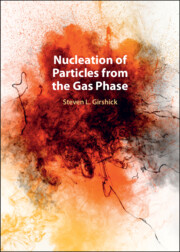Book contents
- Nucleation of Particles from the Gas Phase
- Reviews
- Nucleation of Particles from the Gas Phase
- Copyright page
- Dedication
- Contents
- Preface
- Symbols
- 1 Introduction
- 2 Single-Component Homogeneous Nucleation from a Supersaturated Vapor
- 3 Classical Nucleation Theory
- 4 Classical Theory of Multicomponent Nucleation
- 5 Classical Theory of Ion-Induced Nucleation
- 6 Atomistic Approaches to Homogeneous Nucleation
- 7 Transient Nucleation
- 8 Chemical Nucleation
- 9 Nucleation in Plasmas
- References
- Index
1 - Introduction
Published online by Cambridge University Press: 30 May 2024
- Nucleation of Particles from the Gas Phase
- Reviews
- Nucleation of Particles from the Gas Phase
- Copyright page
- Dedication
- Contents
- Preface
- Symbols
- 1 Introduction
- 2 Single-Component Homogeneous Nucleation from a Supersaturated Vapor
- 3 Classical Nucleation Theory
- 4 Classical Theory of Multicomponent Nucleation
- 5 Classical Theory of Ion-Induced Nucleation
- 6 Atomistic Approaches to Homogeneous Nucleation
- 7 Transient Nucleation
- 8 Chemical Nucleation
- 9 Nucleation in Plasmas
- References
- Index
Summary
Gas-phase nucleation of condensed-phase particles is important in many contexts, including interstellar dust formation, air pollution, global climate change, combustion and fires, semiconductor processing, and synthesis of nanoparticles for practical applications. Nucleation occurs via the growth of atomic or molecular clusters to “critical size” – the size where further growth is irreversible. These critical-size clusters are the nuclei for particle formation, and the growth of clusters to the size of nuclei is the concern of nucleation theory. Various scenarios occur, including single-component homogeneous nucleation from a supersaturated vapor, multicomponent nucleation, ion-induced nucleation, chemical nucleation, and nucleation in plasmas. Classical nucleation theory, which treats small clusters as having the same properties as the bulk condensed phase, is still widely used to estimate nucleation rates for many kinds of systems. However, it is anticipated that atomistic approaches based on computational chemistry will increasingly be used to facilitate more accurate predictions of gas-phase nucleation rates for substances and chemical systems of interest.
Keywords
- Type
- Chapter
- Information
- Nucleation of Particles from the Gas Phase , pp. 1 - 13Publisher: Cambridge University PressPrint publication year: 2024

